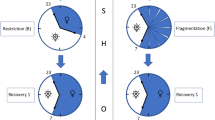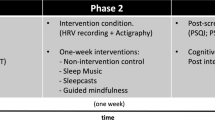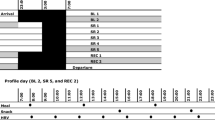Abstract
Difficulty sleeping is a common problem with laboratory polysomnograms. This affects both polysomnograms that are used as a clinical tool to investigate sleep pathology or as an outcome variable in research. The goal of this study was to use a handheld biofeedback device (StressEraser®) to improve sleep quality in the laboratory. Ten subjects without a history of sleep disorders were randomly assigned to either a StressEraser® or no-treatment control condition. A sleep disturbance scale derived from sleep efficiency, REM latency, minutes of stage 1 sleep, and wake after sleep onset was created to evaluate the differences between these groups. Subjects in the StressEraser® group had significantly lower scores on the sleep disturbance scale compared to the no-treatment control group (p = 0.003). Sleep latency was not improved. In conclusion, the StressEraser® significantly improved sleep quality compared to a no-treatment control group. This suggests that the StressEraser® may be an effective tool to help reduce the first-night effect in nighttime laboratory sleep studies.

Similar content being viewed by others
References
Agnew, H. W., Jr., Webb, W. B., & Williams, R. L. (1966). The first night effect: An EEG study of sleep. Psychophysiology, 2(3), 263–266.
Browman, C. P., & Cartwright, R. D. (1980). The first-night effect on sleep and dreams. Biological Psychiatry, 15(5), 809–812.
Buysse, D. J., Reynolds, C. F. III, Monk, T. H., Berman, S. R., & Kupfer, D. J. (1989). The Pittsburgh Sleep Quality Index: A new instrument for psychiatric practice and research. Psychiatry Research, 28(2), 193–213.
Hartmann, E. (1968). Adaptation to the sleep laboratory and placebo effect. Psychophysiology, 4(3), 389.
Heilman, K. J., Handelman, M., Lewis, G., & Porges, S. W. (2008). Accuracy of the StressEraser in the detection of cardiac rhythms. Applied psychophysiology and biofeedback, 33(2), 83–89.
Iber, C., Ancoli-Israel, S., Chesson, A. L., Jr., & Quan, S. F. (2007). AASM manual for the scoring of sleep and associated events. Westchester, IL: AASM.
Johns, M. W. (1991). A new method for measuring daytime sleepiness: The epworth sleepiness scale. Sleep, 14(6), 540–545.
Mendels, J., & Hawkins, D. (1967). Sleep laboratory adaptation in normal subjects and depressed patients (first night effects). Electroencephalography Clinical Neurophysiology, 22, 556–558.
Rosenberg, R., Roth, T., Scharf, M. B., Lankford, D. A., & Farber, R. (2007). Efficacy and tolerability of indiplon in transient insomnia. Journal of clinical sleep medicine, 3(4), 374–379.
Roth, T., Roehrs, T., & Vogel, G. (1995). Zolpidem in the treatment of transient insomnia: A double-blind, randomized comparison with placebo. Sleep, 18(4), 246–251.
Schmidt, H. S., & Kaelbling, R. (1971). The differential laboratory adaptation of sleep parameters. Biological Psychiatry, 3, 33–45.
Sharpley, A. L., Solomon, R. A., & Cowen, P. J. (1988). Evaluation of first night effect using ambulatory monitoring and automatic sleep stage analysis. Sleep, 11(3), 273–276.
Sheehan, D. V., Lecrubier, Y., Sheehan, K. H., Amorim, P., Janavs, J., Weiller, E., et al. (1998). The mini-international neuropsychiatric interview (M.I.N.I.): The development and validation of a structured diagnostic psychiatric interview for DSM-IV and ICD-10. Journal of Clinical Psychiatry, 59(Suppl 20), 22–33. quiz 34–57.
Toussaint, M., Luthringer, R., Schaltenbrand, N., Carelli, G., Lainey, E., Jacqmin, A., et al. (1995). First-night effect in normal subjects and psychiatric inpatients. Sleep, 18(6), 463–469.
Toussaint, M., Luthringer, R., Schaltenbrand, N., Nicolas, A., Jacqmin, A., Carelli, G., et al. (1997). Changes in EEG power density during sleep laboratory adaptation. Sleep, 20(12), 1201–1207.
Vaschillo, E., Vaschillo, B., & Lehrer, P. (2004). Heartbeat synchronizes with respiratory rhythm only under specific circumstances. Chest, 126(4), 1385–1386. Author reply 1386–1387.
Wauquier, A., van Sweden, B., Kerkhof, G. A., & Kamphuisen, H. A. (1991). Ambulatory first night sleep effect recording in the elderly. Behavioural Brain Research, 42(1), 7–11.
Disclosure Statement
This study was supported by a grant from Helicor Inc., maker of the StressEraser®.
Author information
Authors and Affiliations
Corresponding author
Rights and permissions
About this article
Cite this article
Ebben, M.R., Kurbatov, V. & Pollak, C.P. Moderating Laboratory Adaptation with the Use of a Heart-rate Variability Biofeedback Device (StressEraser®). Appl Psychophysiol Biofeedback 34, 245–249 (2009). https://doi.org/10.1007/s10484-009-9086-1
Received:
Accepted:
Published:
Issue Date:
DOI: https://doi.org/10.1007/s10484-009-9086-1




